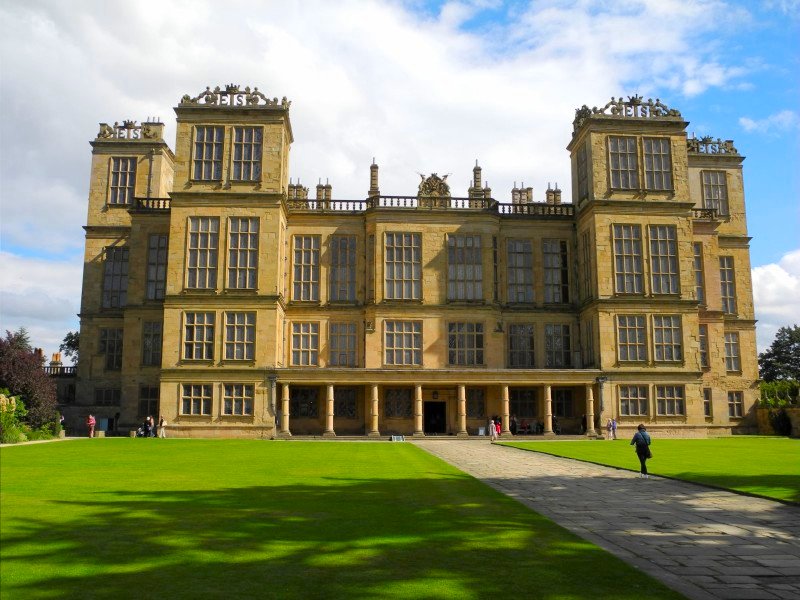An extraordinary woman
Last Saturday we had visitors and the weather looked very uncertain. We therefore abandoned plans to take them to the cotton mill at Styal (which involves quite a lot of walking about outside) and instead headed for Hardwick Hall.
As it happens, this is one of my favourite old houses. I’ve visited it several times, on the first occasion as a schoolgirl. I was surprised on this latest visit to learn that it was acquired by the National Trust shortly after its last domestic resident, the Duchess Evelyn, died in 1960, as I had assumed that I’d originally seen it before the Trust got to work on it (it was very run-down and gloomy then), but I must have been wrong. I suppose it must take years to restore an old house as large as this. Actually, I loved it when it was a bit dirty and dilapidated, though I appreciate that it couldn’t have been left like that. Yet it was very atmospheric; I really felt as if I might have met Bess of Hardwick herself coming down the stairs.
Bess would have been an extraordinary woman at any time, but her achievement was unique in the Elizabethan age during which she flourished (she died when she was 81, and actually spanned almost the whole of the Tudor period). She was born during the early years of Henry VIII’s reign and died five years after James I succeeded to the throne. Of relatively humble background – her family were minor gentry – she gradually made herself one of the most powerful women in England through her four marriages, each husband being richer and more influential than the previous one. I’m not sure how she managed to circumvent the laws about women’s property actually belonging to their husbands that pertained at the time (and for centuries afterwards), but I suppose it must have been something to do with the terms of her widow’s jointures. However she managed it, by middle age she was a very wealthy woman in her own right, with an income of £9,500 p.a., of which we are told that she spent £8,500. By comparison, the humblest labourers on her estate were paid a penny a day.
Bess’s last husband, George Talbot, the Earl of Shrewsbury, was for many years gaoler to Mary Stuart (an unenviable task), and Hardwick contains examples of embroideries that Bess and the exiled Scottish queen worked on together. She and Mary clearly got on well. One of the most famous portraits of Mary hangs in the gallery at Hardwick. Bess also succeeded in maintaining good relations with Elizabeth I. There is another portrait there of Elizabeth, wearing an elaborate dress that Bess presented to her as a New Year’s gift.
I’m certain that Bess would have been a very difficult woman to live with. Obviously always a strong-minded character, by the time she married Talbot her character had hardened into obduracy. Hardwick Hall was indisputably her house, not her husband’s (they also owned the forerunner of Chatsworth). She proclaimed this by having the initials ‘ES’ (for Elizabeth Shrewsbury) carved on its castellations. Hardwick was built right next to the old Hardwick Hall, a much less splendid house, where she had lived as a child. Although she took some of the stone from the old hall to use in the new one, the old one was never demolished: its ruin still stands. She and George Talbot (he also proud and intransigent) did not enjoy a happy marriage and at one point were formally separated. Elizabeth I instructed them to live together again, to set a good example, but it is doubtful if this instruction was carried out in the spirit, if indeed it was observed in the letter.
Bess eventually became the grandmother of Arbella Stuart, who had strong claims to the throne and grew up at Hardwick. As a young woman, she was a semi-prisoner there. Recent excavations have discovered an Elizabethan exercise book which may have belonged to Arbella. This item, obviously, had lain concealed for very many years, but almost everything there is contemporary with the building of the house. The reason that I like Hardwick Hall so much is that the wall-hangings, artefacts and furnishings are more or less as they were in Bess’s time. This is because it was successively used as a hunting-lodge and to accommodate a younger branch of the family, especially after the later Chatsworth was built.
Hardwick is evidently one of the most popular of the National Trust houses; it is almost always thronged with visitors and has been impressively restored by the Trust over the last half century; the loss, especially to me, of its former compelling ambience is a very small price to pay for preserving such a beautiful old house. And I’m certain that, if it were possible to visit it late on a dark winter’s night, it would still be easy to imagine Bess moving down the broad, shallow stone stairs, her rich silk dress swishing slightly as she went.






Those steps look wonderfully eerie!
They are, Rowena. On a dark night, with the wind howling and the tapestries moving in the draughts… is that a step I hear? Shhhh! The creak of a warped door above, the click of a latch…
I used to love visiting “Hardwick Hall, more glass than wall” too – not been for decades. I was thinking about it recently when the site with Bess’s letters came out http://www.bessofhardwick.org/ – must get back some day! Thanks for another reminder.
Yes, Anabel, that little rhyme is one I know well and is very apt for a building of its age! I’m glad to have been able to take you there again. Thank you, too, for the link to Bess’s letters; I shall enjoy having a good look at those. Best wishes to you. 🙂
What a wonderful post, full of atmosphere as well as historical fact. I’d love to visit Hardwick too! The photo of the stairs is particularly charged with ghostly images.
Thank you, Valerie. One of the great things about Hardwick is that it is not so big that the visitor is over-faced with too much detail. We also enjoyed looking around the grounds. There was a cycle event going on in the park and also a famers’ market in the grounds, so it was very busy, but we enjoyed the herb garden, which must have just about every kind of herb available and which was pleasantly quiet. Lots of miniature cyclamen were blooming like crocuses under the trees. Lovely!